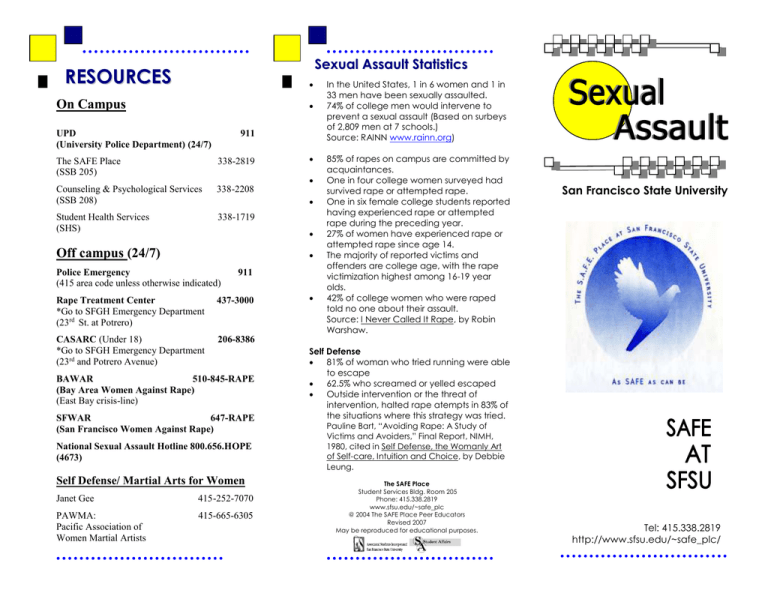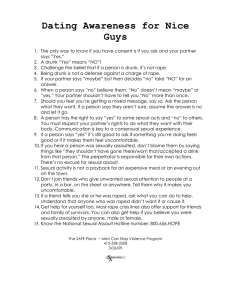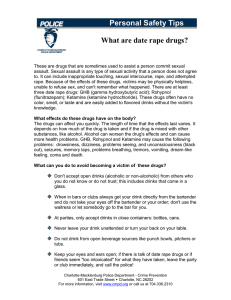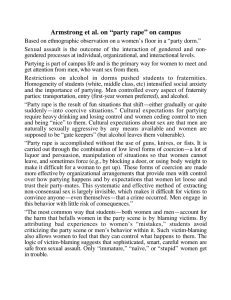
Sexual Assault Statistics
RESOURCES
On Campus
UPD
(University Police Department) (24/7)
911
The SAFE Place
(SSB 205)
338-2819
Counseling & Psychological Services
(SSB 208)
338-2208
Student Health Services
(SHS)
338-1719
Off campus (24/7)
Police Emergency
(415 area code unless otherwise indicated)
911
Rape Treatment Center
*Go to SFGH Emergency Department
(23rd St. at Potrero)
437-3000
CASARC (Under 18)
*Go to SFGH Emergency Department
(23rd and Potrero Avenue)
206-8386
BAWAR
510-845-RAPE
(Bay Area Women Against Rape)
(East Bay crisis-line)
SFWAR
647-RAPE
(San Francisco Women Against Rape)
National Sexual Assault Hotline 800.656.HOPE
(4673)
Self Defense/ Martial Arts for Women
Janet Gee
415-252-7070
PAWMA:
Pacific Association of
Women Martial Artists
415-665-6305
In the United States, 1 in 6 women and 1 in
33 men have been sexually assaulted.
74% of college men would intervene to
prevent a sexual assault (Based on surbeys
of 2,809 men at 7 schools.)
Source: RAINN www.rainn.org)
85% of rapes on campus are committed by
acquaintances.
One in four college women surveyed had
survived rape or attempted rape.
One in six female college students reported
having experienced rape or attempted
rape during the preceding year.
27% of women have experienced rape or
attempted rape since age 14.
The majority of reported victims and
offenders are college age, with the rape
victimization highest among 16-19 year
olds.
42% of college women who were raped
told no one about their assault.
Source: I Never Called It Rape, by Robin
Warshaw.
San Francisco State University
Self Defense
81% of woman who tried running were able
to escape
62.5% who screamed or yelled escaped
Outside intervention or the threat of
intervention, halted rape atempts in 83% of
the situations where this strategy was tried.
Pauline Bart, “Avoiding Rape: A Study of
Victims and Avoiders,” Final Report, NIMH,
1980, cited in Self Defense, the Womanly Art
of Self-care, Intuition and Choice, by Debbie
Leung.
The SAFE Place
Student Services Bldg. Room 205
Phone: 415.338.2819
www.sfsu.edu/~safe_plc
@ 2004 The SAFE Place Peer Educators
Revised 2007
May be reproduced for educational purposes.
Tel: 415.338.2819
http://www.sfsu.edu/~safe_plc/
What is Sexual Assault?
Sexual assault can be broadly defined as
sexual contact that occurs without the explicit
consent of the recipient. A few examples of
acts that are classified as sex crimes include:
How do I know if they want to?
How do I say no?
Talk - Know your own limits and talk about what you
* Touching, fondling, kissing, and other
unwanted sexual contact (Sexual Battery);
want and don’t want. If you want to do something,
*Sexual intercourse against a person’s will
(Rape);
out loud if you don’t want to. If someone pushes
*Sexual intercourse with a minor more than
three years younger (Unlawful sexual
intercourse).
In general, state law assumes that a person
does not consent to sexual activity if he or she is
forced, threatened, unconscious, drugged, a
minor, developmentally disabled, chronically
mentally ill, or believe they are undergoing a
medical procedure.
Perpetrators of sexual assault can be strangers,
friends, acquaintances, family members, male
or female.
Perpetrators may commit sexual assault by
means of overt physical violence, threats,
coercion, manipulation, pressure, or tricks.
Often, sexual assault involves psychological
coercion and taking advantage of an
individual who is incapacitated or under duress
and, therefore, is incapable of making a
decision on his or her own.
Adapted from: Rape, Abuse, and Incest
National Network
http://www.usdoj.gov/ovw/sexassault.htm
(2007)
“Rape, as defined in Section 261 or 262 [of the
California Penal Code] is punishable by
imprisonment in the state prison for three, six, or
eight years.” Someone convicted of a sex
crime has to register as a sex offender for life.
ASK out loud if your partner wants it too. Say “NO”
your limits, tell them out loud to STOP. If they don’t
stop when you tell them to, they have committed a
sexual assault.
Listen – “No” means NO. No one should have to tell
you more than once to stop. ONLY “Yes” MEANS
YES!
RESPONDING TO SEXUAL ASSAULT
Report the assault- You can report the assault to
police and receive emergency care by calling 911.
Get support- Tell someone who understands, such
as a trusted friend , family member or professional
counselor.
COMMON REACTIONS TO SEXUAL ASSAULT
*Feeling responsible or guilty for being in that
situation;
* Anger and/or fear;
* Confusion, especially if the assailant was someone
you know; confusion about what happened,
especially if you were drunk or dosed;
* Loss of trust in others, or in your own judgment,
especially if the assailant was someone you know;
* Shame, embarrassment, disbelief, vulnerability,
betrayal, powerlessness;
* Using drugs, food, sex or alcohol to numb your
pain.
* Flashbacks; depression; problems sleeping, eating,
concentrating, remembering
HELPING A FRIEND
~Listen at their pace.
~Understand that they might experience
conflicting feelings.
~Be supportive & communicate that you
care.
~Respond to their emotions as normal
and understandable.
~Reassure them that they did the best
they could.
~Help them find community and
professional resources.
~Reassure them that they can recover.
Do…
~Tell them you are proud of them for
surviving.
~Let them make decisions.
~Let them cry, yell, talk or be silent.
~Acknowledge that it takes courage to
ask for help.
~Go with them to the ER or home if they
are going by cab.
~Let them know their option to report to
police.
~Take care of yourself too.
Don’t…
~Ask what they were wearing.
~Ask why they were where they were.
~Put them in a cab alone to be taken
home or to the ER.
~Embrace them without asking
permission.
~Blame them – they couldn’t control the
other person’s actions.
~Discourage them from reporting OR
guarantee that their case will be
prosecuted by the District Attorney.
~Take revenge against the accused.
~ Tell others their story without permission.





